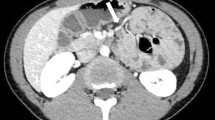Abstract
Introduction
Internal hernias are a rare cause of bowel obstruction, constituting 0.2–0.9 % of all cases with paraduodenal hernias (PDH) being the most common accounting for 50 % of all internal hernias with 75 % of those being left-sided [1, 2]. They are due to small bowel herniating into a peritoneum-lined sac at the fourth portion of the duodenum as the result of abnormal midgut rotation during embryonic development. Patients may present with symptoms of small bowel obstruction, though the majority are found incidentally [3]. Diagnosis is aided with computed tomography (CT) with findings of encapsulated clustering of small bowel loops in the left upper quadrant, bowel between the stomach and pancreas, crowding of mesenteric vessels, and displacement of the inferior mesenteric vein [4].
Methods
A 34-year-old male presented with a 3-year history of postprandial epigastric pain. After multiple inconclusive imaging studies, he was taken to the operating room for diagnostic laparoscopy. The transverse colon was retracted cephalad, and the distal bowel could be seen entering a defect just lateral to the fourth portion of the duodenum. This mass of herniated bowel was readily reduced, and the defect could be appreciated as a 4-cm invagination lateral to the duodenum and posterior to the inferior mesenteric vein. The defect was then closed using interrupted silk suture and the port sites closed.
Results
The patient tolerated the procedure well and was discharged home 24 h later. At 12 months postoperatively, he continued to have intermittent nausea and abdominal pain. Repeated imaging studies including CT scans were negative for obstruction or internal hernia.
Conclusions
PDH are a rare form of internal hernia that result from abnormal midgut rotation during fetal development. Diagnosis is challenging but may be aided by CT imaging. Laparoscopic repair is a safe and effective method of management in these patients [5, 6]. In patients presenting with nausea, vomiting, abdominal pain, and radiographic evidence of PDH, laparoscopic repair should be considered given its safety and efficacy profile. Although surgical intervention did not result in complete resolution of our patient’s symptoms, repair of his hernia removed this diagnosis from his differential and facilitated his ultimate diagnosis of functional abdominal pain syndrome.
Similar content being viewed by others
References
Rollins MD, Glasgow RE (2004) Left paraduodenal hernia. J Am Coll Surg 198(3):492–493. doi:10.1016/j.jamcollsurg.2003.07.025
Khan MA, Lo AY, Vande Maele DM (1998) Paraduodenal hernia. Am Surg 64(12):1218–1222
Frediani S, Almberger M, Iaconelli R, Avventurieri G, Manganaro F (2010) An unusual case of congenital mesocolic hernia. Hernia 14(1):105–107. doi:10.1007/s10029-009-0512-3
Willwerth BM, Zollinger RM Jr, Izant RJ Jr (1974) Congenital mesocolic (paraduodenal) hernia. Embryologic basis of repair. Am J Surg 128(3):358–361
Bittner JG, Edwards MA, Harrison SJ, Li K, Karmin PN, Mellinger JD (2009) Laparoscopic repair of a right paraduodenal hernia. JSLS 13(2):242–249
Hussein M, Khreiss M, Al-Helou G, Alaeddine M, Elias E, Abi Saad GS (2012) Laparoscopic repair of a left paraduodenal hernia presenting with acute bowel obstruction: report of a case. Surg Laparosc Endosc Percutan Tech 22(1):e28–e30. doi:10.1097/SLE.0b013e31823f3798
Author information
Authors and Affiliations
Corresponding author
Ethics declarations
Disclosures
Joshua S. Winder and Randy S. Haluck have no conflicts of interest or financial ties to disclose. Eric M. Pauli receives honoraria from Cook Biotech for teaching.
Electronic supplementary material
Below is the link to the electronic supplementary material.
Supplementary material 1 (MPG 434748 kb)
Rights and permissions
About this article
Cite this article
Winder, J.S., Pauli, E.M. & Haluck, R.S. Laparoscopic repair of a left-sided paraduodenal hernia. Surg Endosc 30, 3636–3637 (2016). https://doi.org/10.1007/s00464-015-4648-1
Received:
Accepted:
Published:
Issue Date:
DOI: https://doi.org/10.1007/s00464-015-4648-1




